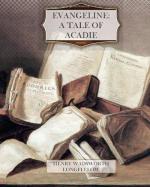E.C. Stedman styles it the “Flower of American Idyls.”
“Evangeline” is a Narrative poem, since it tells a story. Some of the world’s greatest poems have been of this kind, notably the “Iliad” and the “Odyssey” of Homer, and the “Aeneid,” of Virgil. It may be also classified as an Idyl, which is a simple, pastoral poem of no great length.
Poetry has been defined as “impassioned expression in verse or metrical form.” All modern English poetry has metre, and much of it rhyme. By metre is meant a regular recurrence of accented syllables among unaccented syllables. “Evangeline” is written in what is called hexameter, having six accents to the line. An accented syllable is followed by one or two unaccented. A line must begin with an accented syllable, the last accent but one be followed by two unaccented syllables, and the last by one. Representing an accented syllable by O and an unaccented syllable by a -, the first line of the poem would be as follows:
O — — O — — O — — O — — O — — O — This is the forest primeval, the murmuring pines and the hemlocks,
“The measure lends itself
easily to the lingering melancholy which
marks a greater part of the
poem.”
“In reading there should
be a gentle labor of the former half of the
line and gentle acceleration
of the latter half.”—Scudder.
[Illustration: Nova Scotia and vicinity.]
ACADIA AND THE ACADIANS.
Acadia, now known as Nova Scotia, was settled by the French in 1607. Many of the colonists settled in the fertile region about the Bay of Minas, an arm of the Bay of Fundy. One of these settlements was called Grand Pre, meaning Great Meadow. The people were industrious and thrifty and they soon attained a considerable prosperity.
During the early period of American History, France and England were almost continually at war with one another, and in these wars the colonists were concerned. At the close of what is known as Queen Anne’s war, in 1713, France ceded Acadia to the English, and it has since remained in their possession. Some thirty-five years passed before an English settlement was made at Halifax, the Acadians in the meantime remaining in undisturbed possession of the country. Soon after the settlement of Halifax trouble began between the rival colonists.
The Acadians were, as a whole, a quiet and peaceable people, content to till their farms and let the mother countries settle any disputes. Some of them were not thus minded and they succeeded in causing considerable trouble. Frequent attacks were made upon Halifax by the Indians who were supposed to have been aided and encouraged by the Acadians. The Acadians had refused to take the oath of allegiance to the English and this caused them to be regarded with suspicion and fear. They had sworn fidelity on the condition that they should not be required to bear arms against the French, with whom they naturally sympathized, being of the same blood and religion. They persistently refused to go further and swear allegiance.




